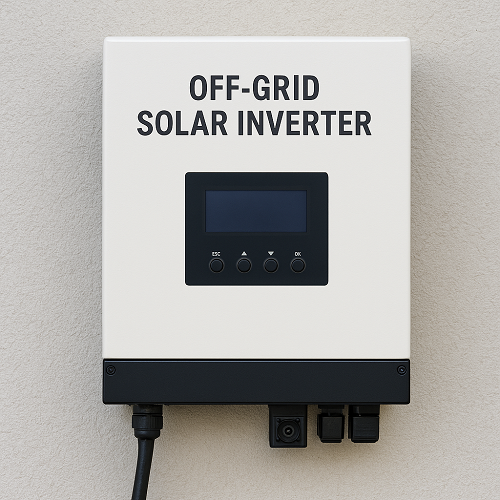In recent years, the global energy landscape has been transforming rapidly. Solar power has emerged as one of the most reliable, scalable, and environmentally friendly energy sources. At the center of many solar systems lies an essential piece of technology—the off grid solar inverter. For households, businesses, and remote installations seeking independence from centralized utilities, understanding the function, design, and technical aspects of off grid solar inverters is crucial.
What is an Off Grid Solar Inverter?
An off grid solar inverter is a specialized device that converts direct current (DC) electricity, generated by photovoltaic (PV) panels and stored in batteries, into alternating current (AC) electricity that can power standard household or industrial appliances. Unlike grid-tied inverters, off grid inverters operate completely independently from the public utility grid, making them indispensable in remote areas or applications where energy autonomy is required.
Core Functions of an Off Grid Solar Inverter
DC to AC Conversion
- Converts DC from solar panels/batteries into AC (120V/240V at 50Hz/60Hz depending on the region).
- Supports pure sine wave or modified sine wave output, with pure sine wave preferred for sensitive electronics.
Battery Management
- Regulates charging and discharging of storage batteries.
- Ensures deep cycle batteries (Lead-Acid, AGM, Gel, or Lithium-ion) are protected from overcharging, deep discharge, and thermal stress.
Load Management
- Provides stable voltage and frequency for appliances.
- Some advanced models allow load prioritization (critical vs. non-critical loads).
System Monitoring and Protection
- Features like surge protection, short-circuit protection, overload shutdown, and thermal management.
- Integrated monitoring with LCD displays, remote apps, or communication protocols (RS485, CAN, Modbus).
Technical Design and Components
A modern off grid solar inverter integrates several key components:
Power Electronics:
- High-frequency transformers or transformerless designs.
- MOSFETs or IGBTs (Insulated Gate Bipolar Transistors) for efficient switching.
Microcontroller/Processor:
- Handles maximum power point tracking (MPPT), system logic, and load balancing.
Cooling System:
- Heat sinks and intelligent fans for thermal regulation.
- Some high-end inverters employ liquid cooling for large capacities.
Battery Interface:
- Voltage compatibility (12V, 24V, 48V, or higher for industrial systems).
- Support for modern lithium-ion battery management systems (BMS).
Communication Interfaces:
- Wi-Fi, Bluetooth, RS232/RS485, and cloud-based monitoring.
Off Grid vs. Grid-Tied vs. Hybrid Inverters
| Feature | Off Grid Inverter | Grid-Tied Inverter | Hybrid Inverter |
| Grid Dependency | Independent | Requires grid | Works both ways |
| Battery Support | Yes | Optional/No | Yes |
| Typical Use | Remote areas, backup systems | Urban solar rooftops | Flexible residential/commercial |
| Cost | Moderate-High | Lower | Highest |
Key Technical Specifications to Consider
When selecting an off grid solar inverter, engineers and users must evaluate:
Power Rating (kW or kVA)
- Must match the total load demand plus surge capacity for appliances like refrigerators, pumps, and motors.
Battery Voltage Compatibility
- Common standards: 12V, 24V, 48V, 96V, or 120V.
- Higher voltage systems reduce current and conductor losses.
Efficiency
- Typical range: 85–95%.
- Losses occur during DC/AC conversion and in standby consumption.
Waveform Quality
- Pure sine wave output is essential for electronics, medical devices, and motors.
- Total Harmonic Distortion (THD) should be <3%.
Surge Power Capacity
- Ability to handle sudden load spikes (typically 2–3× rated capacity).
Maximum Power Point Tracking (MPPT)
- Ensures optimal extraction of energy from solar panels under varying sunlight conditions.
Protection Mechanisms
- Over-voltage, under-voltage, over-temperature, short-circuit, and overload protection.
Environmental Ratings
- IP65/IP66 for outdoor models (dust- and water-resistant).
Installation and Design Considerations
System Sizing
- Accurate calculation of daily energy demand (kWh/day).
- Proper sizing of solar panels, batteries, and inverter capacity.
Battery Bank Configuration
- Series vs. parallel arrangements to meet voltage and capacity requirements.
- Ensure compatibility with inverter’s charging profile.
Cabling and Protection
- Correct gauge of wires to minimize resistive losses.
- Installation of fuses, breakers, and surge protectors.
Cooling and Ventilation
- Off grid inverters generate heat—adequate airflow is critical.
Redundancy
- Parallel inverter setups for higher loads and fail-safe operation.
Common Technical Issues with Off Grid Solar Inverters
- Overheating: Caused by poor ventilation or excessive load.
- Battery Mismatch: Using incompatible batteries leads to reduced lifespan.
- Voltage Fluctuations: Inadequate surge handling may trip sensitive devices.
- Firmware Issues: Some smart inverters require updates to maintain optimal MPPT or communication.
- Harmonic Distortion: Low-quality inverters produce high THD, damaging sensitive electronics.
Advanced Features in Modern Off Grid Inverters
- Smart Monitoring Systems with IoT integration.
- Modular/Stackable Design for scalability.
- Lithium-ion Optimization with CAN-Bus communication for precise charging.
- Hybrid Mode Support in certain models (allowing backup from generators or limited grid supply).
- Grid-Forming Capability for microgrids.
Applications of Off Grid Solar Inverters
- Residential Homes in Remote Areas: powering appliances without utility connections.
- Telecommunication Towers: ensuring 24/7 uptime with solar-battery backup.
- Rural Healthcare Clinics: reliable power for critical medical equipment.
- Agriculture & Irrigation: solar pumps and cold storage.
- Emergency and Disaster Relief Camps: mobile and portable off grid systems.
Future Trends
- AI-Optimized Energy Management: predictive load control and fault detection.
- Higher Voltage Systems (>400V DC): reducing conductor sizes and improving efficiency.
- Integration with Energy Storage Systems (ESS): large lithium-ion or flow battery banks.
- Sustainable Materials: recyclable electronics and reduced rare earth usage.
An off grid solar inverter is far more than just a DC-to-AC converter. It is the heart of any stand-alone solar energy system, managing power flow, protecting equipment, and ensuring energy independence. Whether deployed in a rural home, a telecom site, or an agricultural field, its design and performance directly impact system reliability and efficiency.
































